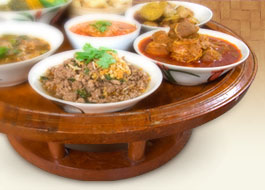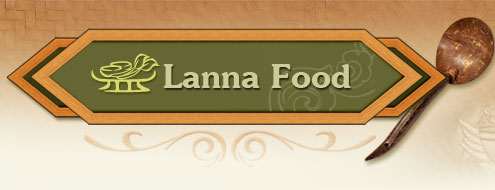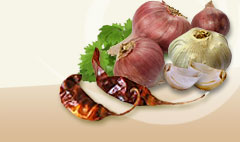Purple eggplant |
|
|
 | Solanum melongena |
|
| |
 | Solanaceae |
|
| |
 | Purple eggplant |
|
| |
 | Makhuea muang-lek (makhuea kham-ma), makhuea muang-yai, makhuea kae, makhuea chan si-muang, makhuea phae (Thawithong Hongwiwat, 2004, p. 54-56) |
|
| |
 | Annual shrub 0.5-1 m. high. Strong stem, green or purple, slightly thorny. Leaves alternate broadly ovate or suborbicular, hairy underneath. Flowers short racemes, axillary or terminal, purple with 5 petals with 5 ovate lobes, 5 stamens and 1 pestil. Fruit round light green or purple or white, shiny and smooth, with numerous round, flat seeds. (Kanchana Diwiset, et al., comp., 1999, p. 195). The green ones is the most popular in Thailand whereas the purple kind in Japan (Thawithong Hongwiwat, 2004, p. 53). |
|
| |
 |

The fruit contains B1, protein, calcium. According to the Health Department, 100 gm. gives 26 kilocalories and fat 0.3 gm., carbohydrates 4.9 gm., protein 0.9 gm., fiber 0.9 gm., calcium 19 mg., phosphorus 44 mg., iron 2.6 mg., Vitamin A 354 IU, Vitamin B1 0.09mg., Vitamin B2 9.06 mg. and Vitamin C 3 mg. but no niacin. (Maprang, 2005, p. 112) The Fruit is boiled or grilled to set with namphrik or made into yam makhuea yao, deep fried with egg, stir-fried by itself or with long beans or put in green curry. |

Eggplants prevent the blood veins from breaking too easily as well as prevent high blood pressure and scurvy. It also has anti-oxidant properties. (Maprang, 2005, p. 112). Stalk and roots prevent dysentery, bloody feces, and athletes foot. Leaves are a diuretic and prevents gonorrhea as well as inflammation. Dried fruit are made into a pain killer tablet, prevents bleeding in the intestines and used as expectorant. Fresh fruit are pulverized and put on wounds to stop inflammation. Dried fruit stem are burned to get the ashes for medicine to prevent gastritis. (Kanchana Diwiset, et al., comp., 2005, p. 183) |
|
| |
 | All year round |
|
| |
 |
Kanchana Diwiset, et al., comp. (1999). Phak Phuen Ban Phak Klang. Kanchana Diwiset, ed. Nonthaburi: Project for Text Development of the Institute for Traditional Thai Medicine. (inthai). Maprang. (2005). Khun Kha Phak Khue Ahan Lae Ya A-Yu Watthana. Bangkok: Phailin. (inthai). Rattana Phromphichai. (1999). Khuea, Ba. inSaranukrom Wattanatham Thai Phak Nuea(Vol. 2,p. 866). Bangkok: Siam Commercial Bank Foundation for the Encyclopedia of Thai Culture. (inthai). Thawithong Hongwiset. (2004). Saranukrom Phak. (2nd ed). Bangkok: Saengdaet. (inthai). |
|
| |
|
|




